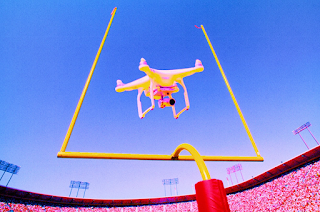Super Bowl security prepares for drones with trackers and jammer
The NFL and federal law enforcement are on high alert for unauthorized drones after one caused a play stoppage at a playoff game two weeks ago.
Super Bowl LVIII will feature a tough defensive scheme that has nothing to do with a football. This one is about stopping drones.
The NFL and federal law enforcement officials are taking a hard line Sunday to keep players and fans safe from unauthorized drones at Allegiant Stadium in Las Vegas where the Kansas City Chiefs will play the San Francisco 49ers.
Unapproved drone flights have become a persistent problem for the NFL, as well as for other sports leagues and large public gatherings. The NFL said there were about 2,500 drone incursions near stadiums during the 2022-2023 season, an increase of about 90% from a year earlier.
The flights have sometimes encroached on televised broadcasts, including two weeks ago at the AFC championship game in Baltimore when an unapproved drone violated the restricted airspace. Federal prosecutors later charged a Pennsylvania drone pilot who said, according to the FBI, that he wasn’t aware of the flight restrictions.
Possible criminal charges and civil penalties await anyone trying something similar Sunday, officials said.
“So please leave your drone at home,” Cathy Lanier, the NFL’s chief security officer, said at a news conference Wednesday.
Most of the drones are operated by hobbyists seeking aerial video, according to experts, but especially at a high-profile event such as the Super Bowl, authorities said they’re also looking out for people with more nefarious intentions.
Homeland Security Secretary Alejandro Mayorkas said the incident two weeks ago was a warning.
“It does not require much imagination to understand the significant threat such an incident could pose,” he said at the news conference Wednesday. Although no one was hurt in that incident, he said, “what happened in Baltimore underscores the vital importance of the mission.”
Mayorkas added that there were no known credible specific threats to the Super Bowl or Las Vegas.
Federal law enforcement designates the Super Bowl as a top-tier security event, on roughly the same level as a presidential inauguration ceremony or a visit by the pope. Allegiant Stadium, where the teams will play, has a capacity of about 65,000 people.
Any stadium’s defense against drones has multiple layers, said Mary-Lou Smulders, chief marketing officer for Dedrone, a Virginia-based company. Its drone countermeasure technology is in use by the Las Vegas Metropolitan Police Department, which covers Las Vegas and its major stadiums.
“Like any security issue, the more layers you add, the safer you are,” she said. “The same applies to airspace security.”
The first layers, she said, are all designed to detect and track drones using at least three types of technology: radio-frequency sensors, cameras and radar. They have different strengths, she added: Radio-frequency sensors can distinguish between drones and other objects better than radar, while radar has a longer range and a camera can help determine if a drone is carrying a payload.
With a camera, Smulders said, “the most interesting thing to ask is: Is it carrying a payload, yes or no?” If it were, that “would dramatically affect your security posture.”
A second set of layers is designed to interfere with a drone’s flight, she said: “cell phone jammer jamming” or cutting off the radio communication between a drone and its pilot; hacking into a drone to take over control; and locating the pilot on the ground and arresting the person.
drone jammer Jamming and hacking are not usually available as security tools for an NFL game. Federal law restricts who can interfere with a drone’s flight, and in the United States, only a few government agencies including the Department of Homeland Security and the FBI have the authority to do so. Congress is considering legislation to change that but, for now, the federal government provides agents for high-profile events like the Super Bowl but not for a game on any given Sunday.
At a regular season game in Baltimore in November, play was delayed twice because of drone activity.
The NFL game stoppages are helping raise the profile of drone countermeasures, a growing industry that experts say will become more important as drone technology improves and becomes cheaper.
Allegiant Stadium has one advantage over Baltimore’s: It’s a domed stadium, with a roof to shield the game from anything overhead. But it’s not completely enclosed, Smulders noted: The stadium has 80-foot walls that are retractable if weather allows. The doors have usually been closed during games.
Still, the NFL is on higher alert for drones than it used to be. In 2017, a California man used a modified drone to drop leaflets on the 49ers stadium, authorities said. He then drove to nearby Oakland and did the same at a Raiders game. He later pleaded guilty and was sentenced to probation.
For Sunday, the Federal Aviation Administration has banned drones within a radius of 30 nautical miles (about 35 miles) of the stadium beginning one hour before kickoff. There have also been restrictions in place for additional events in Las Vegas the past few days.
Lanier has previously told NBC News that the NFL had a close call at the Super Bowl in Atlanta in February 2019, when an FBI team spotted a drone just before six Air Force F-16s were set to conduct a flyover before the game. The F-16s flew at a higher altitude to avoid a possible collision, she said.



Comments
Post a Comment